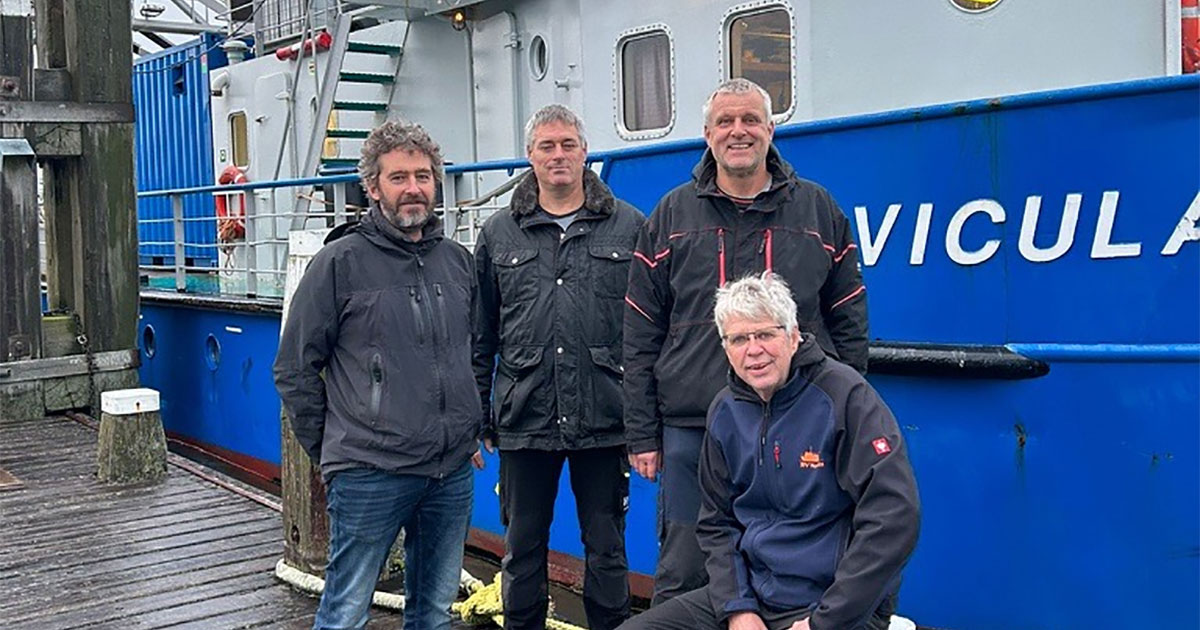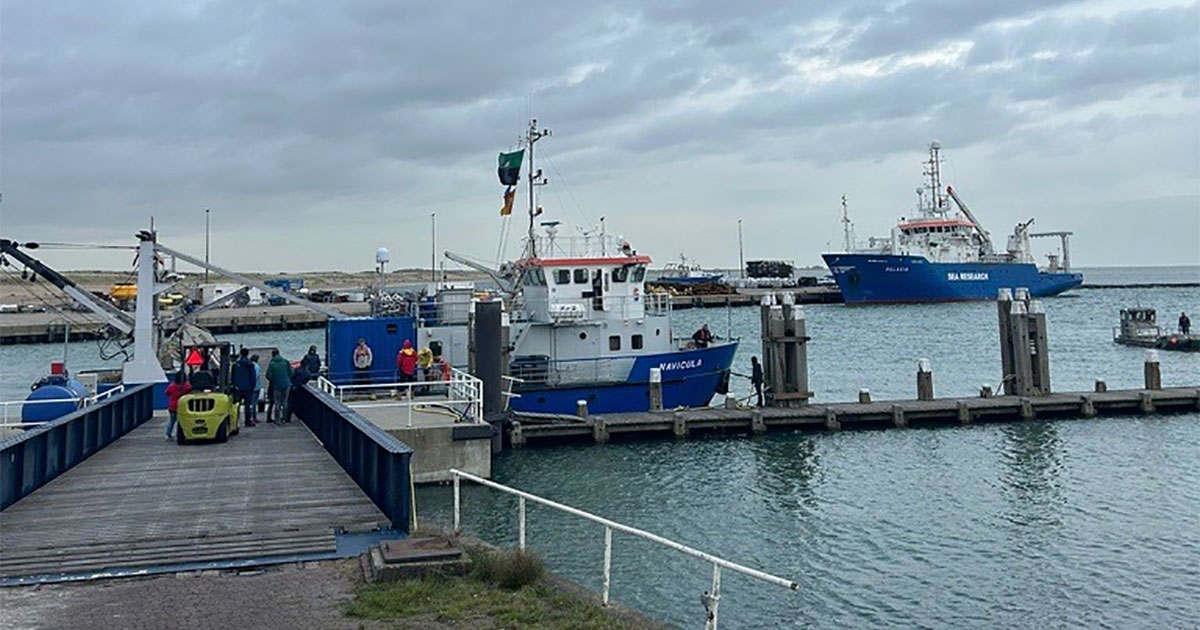On Thursday November 9, the RV Navicula returned to Texel from her last planned cruise for the National Research Fleet. Since 1980, she has made a lot of research possible on water movements, plankton, benthic animals, fish and birds in the Wadden Sea, the Southwestern Delta and the coastal areas of the North Sea.
Crew and researchers look back on their experiences with 'the little ship'.
Former head of the Coastal Systems department at NIOZ (Royal Netherlands Institute for Sea Research), Henk van der Veer, and his good friend and former colleague Mardik Leopold, now researcher at Wageningen Marine Research, spent "a lot of time on board the Wadden ship Navicula and had many adventures." Both of them first boarded the then only one-year-old ship in 1981 for their research. Van der Veer studied plaice in the Wadden Sea, Leopold seabirds in the North Sea.
First Research Vessel for Shallow Water
Van der Veer: "The Wadden Sea is the nursery of flatfish such as plaice. Every spring, the young fish wash in and out of the Wadden Sea with every tide. For my PhD research, I monitored the numbers." The Navicula was the first vessel built with all the research capabilities for such a specific area as the shallow Wadden Sea. "That was a breakthrough and on top of that: you could also stay at sea a whole working week," he says.
And they enjoyed doing so, especially in those early years. Leopold: "In those days, things were still very easy: if you had a good idea, then you could have the ship. All I wanted was to count seabirds all day. Lunch was an annoying interruption of the counting. At one point, the cook even took my lunch up to the bird station on top of the ship, but that was not a huge success: the wind blew the food all over the back deck."
Washing Machine
Leopold claims he is a record holder as a researcher on the Navicula: "I travelled huge distances, from Calais to Helgoland and Esbjerg. I always asked the skipper for the maximum. At some point he would have to say no, but the crew appreciated that we loved sailing so much." However, cruising with a limited draught of only one meter, did sometimes feel "like a big washing machine" in Leopold's words: "We did experience 8-meter-high waves at times." Van der Veer recalls the German Bight: "Once the television came down there."
On the other hand, they have also been in places that were too shallow, even for the Navicula. Van der Veer: "We once sailed backwards across the mud flats. This made the ship 10 cm more shallow because the propeller pushed the water under the ship. That way you could get further."
Despite these challenges, Van der Veer says it was always responsible on board. "So much was possible because there was always a good crew. As a result, you always had a safe feeling as a passenger." Leopold: "The skippers came from fishing ships and were very capable."
Marine Nature Reserves
Looking back, the scientific work done from the Navicula has been instrumental in securing Dutch nature at sea. Seabird specialist Leopold: "All that counting of birds on the North Sea side of the Wadden Islands in the 1990s eventually led to the establishment of Natura 2000 area 'North Sea Coastal Zone'. That zone runs from the low-tide line to the -20 m depth line, from Bergen aan Zee to the German border. So, the 'signature' of the Navicula is on the sea chart these days!"
Another great example is the SIBES program, in which marine researchers aboard the Navicula sample benthic organisms and sediment at 4,500 locations on the plates of the Dutch Wadden Sea each year. This provides insight into the relationship between food availability and fish and bird abundance. The effects of human activities can also be measured.
Own Culture
By the time Hein de Vries came to work on the Navicula as cook in 2002, the ship had been in operation for 20 years. Skipper Bram Fey started in 2011. With machinist Klaas-Jan Daalder, they have formed the current permanent crew on the ship since 2012. Fey and De Vries praise the in-house culture on the Navicula. "Ever since the beginning, I have been baking pancakes every morning," says De Vries. "I start doing that at a quarter past six. And every Wednesday I make an Indian rice table ‘de Blauwe Hap’."
In the team, a lot comes down to good cooperation. Fey: "It's a small ship with only three crew members. That only works because we are flexible and we look out for each other. You do have your own role and tasks, but you also do a lot of other things. For example, Hein would first stand on deck with an orange life jacket on and a helmet to help outside, only to quickly dive into the galley afterwards." Together, they have been doing the dishes by hand every evening for years. De Vries: "Mind you, it's a galley so small you can't even pass each other there."
 Crew of the RV Navicula. (Image credit: NIOZ)
Crew of the RV Navicula. (Image credit: NIOZ)
New Standards
Over the years, the Navicula has undergone many renovations, according to Fey and De Vries. The biggest change took place in the year 2000, when the ship was lengthened 4.5 meters to make room for extra working space and two extra showers. But even after that, the ship has been adapted several times to ever new standards. De Vries: "It has been emptied inside and the galley has been completely refitted." Fey adds, "a lot changed because of IT, when computers and servers were added."
The ship also got what is known as a whisper set at some point. "Before then, the power generator made such a terrible noise. Once we were kindly but urgently requested to leave in the middle of the night in Dordrecht, when we were next to a retirement home," laughs De Vries.
Camping Life
Currently, with the commissioning of Navicula's successor the Wim Wolff, both crew members are especially looking forward to what they see as a relocation. De Vries: "The last few years it was like the Dutch reality tv program ‘Campinglife’ on the Navicula. You didn't have your own shower, you had to share everything." Fey: "In terms of wishes for comfort, a lot has changed. The Navicula is becoming too small for that, every square inch of the ship is being used. In recent years, for example, due to lack of space, we could only store canned goods for the kitchen in the technology room. On the Wim Wolff, life will be just a bit more spacious."
In terms of sailing and research technology, too, things have been a bit of a struggle for a number of years. Fey: "So much more is possible now to make the work easier. For example, when we are sampling and I have to keep the ship in one place, I have to push a button continuously, sometimes for hours or even the whole day. If I don't, she immediately turns in the wind and you have to start all over again." Fey won't miss that task at all.
More Sustainable Successor
Navicula's successor, RV Wim Wolff, will not only be more modern and comfortable, but also a lot bigger than the Navicula. "The Navicula could take eight passengers and the Wim Wolff as many as 12," says Fey. Moreover, the new ship offers opportunities in terms of sustainability. "The Wim Wolff has diesel-electric propulsion and battery packs, allowing us to sail more economically. The fuel is not normal diesel but hydrotreated vegetable oil, which reduces emissions of nitrogen, particulates, sulfur and CO2. And in the future, we will be able to switch to other types of fuel such as methanol, ammonia or hydrogen."
The Wim Wolff will also offer Wadden researchers more research opportunities. For instance, the new ship contains a so-called plankton sampler, which can be used to continuously measure the composition of algae in the water.
Despite the enthusiasm about the new Wadden ship, crew members and scientists agree that the Navicula was a very good research vessel for many years. Henk van der Veer concludes, "So that's why the Wim Wolff is actually a modern copy of the Navicula."



